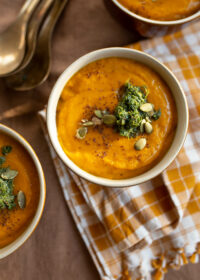Recipes: The Yogi Bowl

In between long days of teaching and practicing yoga, this recipe has become my go-to for an easy, energizing lunch. The mix of cooked and raw ingredients provides a feeling of grounding nourishment without feeling heavy or weighed down in the afternoon. It balances flavors of sweet, salty, pungent, astringent and bitter – making this a perfect Ayurvedic meets macrobiotic-friendly meal. And more importantly, it meets the criteria of a sattvic meal. If you’re a practicing yogi, you’re probably well-versed in this concept, but those new to the term here’s more on what it means to eat sattvic food and why it’s so beneficial for our bodies and minds…
Sattvic Food – Food for a Quiet Mind
“Our food choices reflect the ongoing harmony with ourselves, the world, all of creation, and the divine.”
–Gabriel Cousens, M.D., Conscious Eating
Ayurveda explains that certain foods affect the qualities of the mind in different ways. These different qualities, known as the Gunas, are categorized into three primary groups: sattva, rajas, tamas. A sattvic mind is clear, peaceful and harmonious. A rajasic mind is active, restless, aggressive and worldly. The tamasic mind is lethargic, impulsive, cruel and degenerate. Because our thoughts, words and actions are shaped by how we feel, our diet directly influences these states of mind, and in return the mind affects our diet choices. Thus, the foods we choose shape our consciousness and our interactions with the world.
Since every food contains these different properties of sattva, rajas and tamas, we can consciously create the state of mind we would like to produce by what we consume. The ancient texts, like the Hatha Yoga Pradipika and the Bhagavid Gita, explain that a sattvic diet is necessary for a pure mind and promotes longevity, goodness, strength, health, happiness, and pleasure. A modern sattvic diet can be described as one that avoids meat, fish, eggs, alcohol, caffeine, bleached flours, white sugar and other processed, irradiated foods. This diet instead focuses on high prana, living foods that consist of organic, whole, natural fruits, vegetables, nuts, seeds and grains grown in harmony with nature on good soils and cultivated with an attitude of love. When we consume these foods, it produces clear thinking, loving actions, and an open heart. It produces expansion, rather than contraction. Gabriel Cousens says in his book Spiritual Nutrition, “It emphasizes increasing prana (life-force) and the subtle elements of air and ether that help open the mind and heart and make them more sensitive.” A sattvic diet, which is essentially a plant-based diet, removes excess weight and toxins that are heavy in nature in the body and mind, and provides a lightness of body, mind and spirit for peaceful reflection in our meditation and yoga practices.


Ginger Miso Tahini Dressing
1/3 cup tahini
2 tbsp white miso paste
1 inch fresh ginger, skin removed
1 small clove garlic (optional)
1 tbsp tamari
1 lemon, juiced
1/2 cup water
Combine all ingredients in a high-speed blender, blend until creamy. Pour into an airtight container to store. Stores up to 10 days in your fridge. Makes 2 cups
Note: Garlic and onions are not a part of a traditional sattvic diet, if you have too much heat (pitta) in the body or find your mind is easily aggravated by these ingredients, please exclude the garlic from the tahini dressing.
Salad Bowl
6 leaves kale, stems removed, washed & torn
1 tbsp olive oil
1 small sweet potato, cubed & roasted
1/2 cup cooked brown rice (quinoa or millet)
1 tbsp gomashio
Preheat oven to 375. Wash and cut sweet potato into 1″ cubes, toss in olive oil and sprinkle with salt. Place on a baking sheet and roast at 375. While roasting, prepare kale by washing well, removing stems and tearing leaves into small pieces. Place in a large bowl and massage with olive oil to break down the rough texture. For a cooked option, lightly blanch the leaves in a pot of boiling water to soften before transferring to the bowl and adding the olive oil. Check the sweet potato, stir to avoid sticking or burning on the pan. Once tender, remove from oven.
To serve, scoop 1/2 cup of warm cooked brown rice (or cooked grain of choice) on top of the massaged kale. Top with roasted sweet potato, a healthy heaping of the tahini dressing, and a big sprinkle of gomashio (a seaweed/sea salt/sesame blend).
Makes 1 large bowl for a hungry yogi
 [wpmenucart]
[wpmenucart]



That dressing sounds amazing!! Definitely giving this one a go – it is EXACTLY what I feel like today. X
Whenever I have one of those indecisive “what do I want to today?” moments – this is always my go-to! I hope you enjoy!
[…] variation of my “Yogi Bowl” recipe with raw greens + sprouts, cooked sprouted brown rice, roasted veggies or avocado and […]
Why are you including garlic in a sattvic dish???? I am disappointed seeing this in your recipe. I am new to sattvic diet, and need better info than this. Will not return to your site again.
Thanks Fred for your insight. You are correct, garlic and onions are not a part of a traditional sattvic diet. I, personally, however, do well with a small amount of garlic and cooked onion in my diet, and therefore my personal recipe blog reflects this. I think it’s a wonderful addition to note that if you are following a traditional sattvic diet to omit this ingredient from the tahini sauce recipe. Additionally if you have too much heat in the body or find that alliums aggravate your constitution, then it’s probably best to avoid these in your daily diet. You might enjoy reading more about the sattvic diet in Gabriel Cousen’s book on Spiritual Nutrition or any of Vasant Lad’s books on Ayurvedic cooking. Many blessings to you on your path!
Thanks Fred for your insight. You are correct, garlic and onions are not a part of a traditional sattvic diet. I, personally, however, do well with a small amount of garlic and cooked onion in my diet, and therefore my personal recipe blog reflects this. I think it’s a wonderful addition to note that if you are following a traditional sattvic diet to omit this ingredient from the tahini sauce recipe. Additionally if you have too much heat in the body or find that alliums aggravate your constitution, then it’s probably best to avoid these in your daily diet. You might enjoy reading more about the sattvic diet in Gabriel Cousen’s book on Spiritual Nutrition or any of Vasant Lad’s books on Ayurvedic cooking. Many blessings to you on your path!
I like to use asafetida as a substitute for garlic and onions…have you tried this condiment, Claire?
Hi Sara! Yes, asafetida is fabulous. I use it in my kitchari sometimes, it gives it a little oomph and rounds out all the flavors. Great idea for a sattvic yogi bowl substitute!
Wow this looks beautiful. Thanks for sharing, I imgagine this will become a staple recipe for me!
Thanks, Anna! With cold weather around this corner, this one has come back on my staple list 🙂 I hope you enjoy!
[…] Yogi Bowl […]
This was soooo very delicious…I used quinoa instead of rice and add some boiled green bean. The tahini sauce itself is magic too…
Hi there Claire, you have a beautiful and informative site. I´m loving it!
I have a doubt, I think I´ve read that fermented foods like misso and tamari, which I personally love, are considered tamasic, like mushroms too, is that correct? Do you know why?
[…] and keeps you feeling fresh. It includes lots of fresh fruits, vegetables and milk. Try this yum Satvic Yogi Bowl for dinner. We know you won’t reach for the bag of chips […]
[…] Recipe Box: The Yogi Bowl + A Simple Sattvic Meal […]